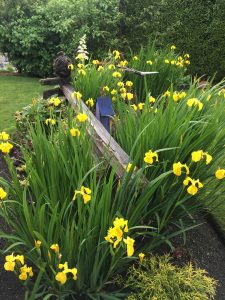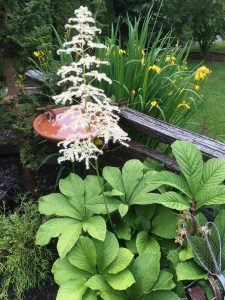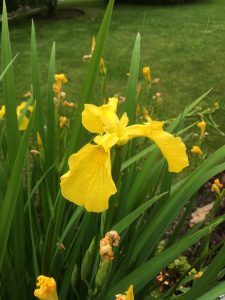Strata (multi-family) sites come in all shapes and sizes and my job, all year, is to maintain their landscaping. And I’m rarely wowed or surprised as I work in the landscapes. But it can happen.
Corner garden
As I line trimmed around a corner I literally ran into a nice wave of yellow. What do you think?
I love warm yellow colours and the Irises deliver lots of warmth. I also immediately noticed the Rodgersia in the background. Aside from its prominent flower spike, it sports tough leaves. I was first introduced to this plant when I worked under municipal gardener Tracy Mallinson.
I also noticed nice bed edges and a ball made out of driftwood.
Overall, this whole corner works for me. It was fun working around it and taking pictures of it on company time.
Twist
I posted my corner discovery in one Facebook group and many members liked the picture. Except for one friend, Heike Stippler, who is the ultimate green professional and owns her own Heike Designs business based in Whistler. Because she is also involved with the Invasive Species Council of BC she gently pointed out that the Irises above are invasives called Iris pseudocorus or Yellow flag iris. Bummer. I had no idea. I was just taken with the yellows.
Then I remembered that several seasons ago, while working in the Klahanies neighbourhood in Port Moody, British Columbia, I had to remove several Yellow flag Irises because they were close to a stream that empties into the Inlet and is currently populated by beavers. The resident who called in the removal request sounded like the world was ending.
Iris pseudocorus
For this section I am openly borrowing from the Invasive Species Council of BC website. As it turns out, I’m not the only person wowed by this yellow Iris. It’s a popular, eye-catching plant and allegedly sells well at nurseries and garden centres.
The problem is that this Iris forms dense stands in wet areas and pushes out native plants. When cattails, sedges and rushes are pushed out, birds lose nesting areas. The yellow flag iris can invade irrigation canals, ditches, shallow ponds and stream and lake shorelines.
Since the iris is invasive it makes sense that it reproduces quickly through seed dispersal and horizontal root systems.
Conclusion
Be careful when you fall in love with a yellow Iris. One suggested alternative plant is Iris ‘Butter and sugar’. Since this spot is buried deep inside a huge strata complex and far from water it’s unlikely to invade anything but winds are unpredictable. I would consider replacement with some other plant just to be on the safe side.







